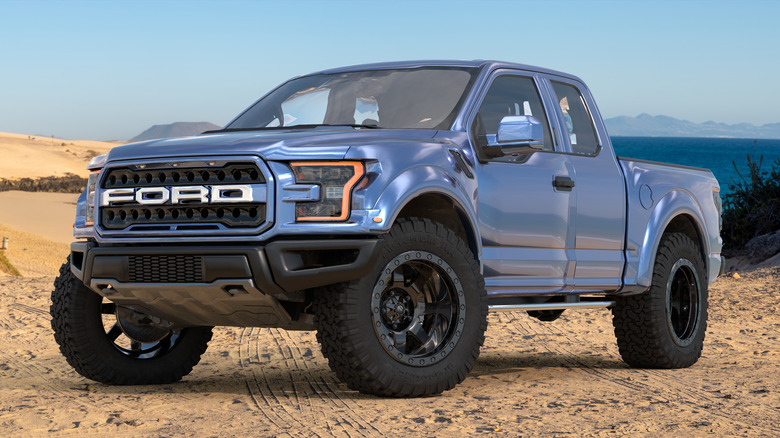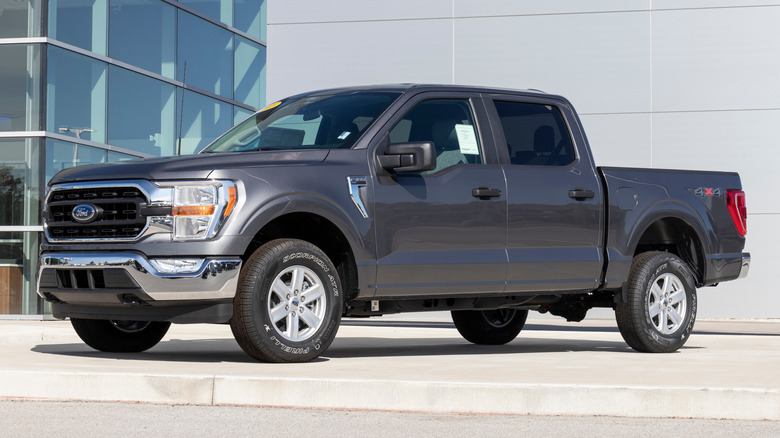The Big Difference Between The Ford F-150 And The Ford Raptor
Americans have an uncanny love for pickup trucks, and the Ford F-series has long been their preferred choice. The F-Series was hailed as the best-selling car model in the U.S. for June 2022 (via MarkLines), while Statista predicts Ford's dominance in the segment is set to continue over the next several years. The automaker offers numerous models and engine options in its F-series, including the energizing (literally) F-150 Lightning electric pickup truck, increasing its appeal among pickup enthusiasts.
But if you want to stick with the conventional fuel options, the automaker has several to choose from, including an affordable (relatively speaking) all-utility model like the Ford F-150 or the hardcore and muscular Ford F-150 Raptor, which is perfect for off-roading. Feeling a bit confused by the various options and which one you should go with? Here are some of the most significant differences between the Ford F-150 and the Ford Raptor.
Multiple engine options
The Ford Raptor decidedly has a more appealing design with sharper headlamps and a bolder front grille, but that is not all: you get a much more powerful engine inside. The Ford Raptor packs a 3.5-liter EcoBoost V6 engine with an astonishing and unusual 10-speed auto transmission. The 10-speed shiftable automatic gearbox allows for shorter shifts and more traction in the lower gears, which is extremely useful when lugging a heavy load on a rough surface (via Ford).
In contrast, the Ford F-150 gets a relatively smaller yet decently powerful 2.7-liter turbocharged engine also arranged in a V6 configuration as the lowest trim option; the engine is paired with a 10-speed automatic transmission. With the 2023 F-150 model, Ford offers multiple engine configurations besides the 2.7-liter variant: you can also get a 3.0-liter V6 engine, a 3.3-liter V6, a 3.5-liter twin-turbocharged V6, or a 5.0-liter V8 as the engine (via Ford).
The trade-off between power and utility
In terms of the power produced by both engines, the Ford F-150 outputs a minimum of 290 horsepower. The 5.0-liter version of the F-150 churns out 400 horsepower, but you can also get the same with the 3.5-liter twin-turbo engine with a 35kW electric motor to give it the tag of a hybrid. Meanwhile, the Ford Raptor has a much higher power throughput of 450 horsepower with the base trim. You'll also be able to choose the 5.2-liter V8 engine with the Ford Raptor R, which is expected to generate a power of 760 horsepower. The Raptor R is to be unveiled on July 18, 2022, at which point we'll get more details.
Notably, the Ford Raptor gets an all-wheel-drive standard, which is crucial for navigating challenging landscapes. With the F-150, on the other hand, you get the option to choose between rear-wheel and four-wheel-drive options with any of the mentioned variants. The Ford-150 has noticeably better capabilities regarding towing and lugging payload. The model's trunk can hold between 1,840 and 3,250 pounds based on the engine variant, while it can tow a trailer that weighs between 12,000 and 14,000 pounds. In comparison, the Raptor has a lower payload capacity of only 1,400 pounds and has a tow rating of 8,200 pounds, making it relatively less appealing for carrying or pulling heavy objects.
They have different budget demands
With all this power, fuel economy tanks very quickly. According to the EPA's estimates, the 2.7-liter engine variant of the 2023 Ford F-150 is claimed to let you drive roughly 20 miles per gallon in the city and 26 on the highway. If you care more about savings, it is better to go for the hybrid variant with a much higher fuel economy of 25mpg in the city. Meanwhile, the Raptor will guzzle down fuel much faster than its less powerful sibling. Choosing the 3.5-liter variant means the fuel economy drops to 15mpg in the city, according to EPA.
The power ratings also impact the pricing of the two Ford trucks. The Ford F-150 has a starting price of $32,000 for the lowest XL trim whereas the Platinum can go as high as $64,000. In contrast, the spendings are much steeper in the case of the Raptor, which is going to set you back $72,000. These are likely among the biggest differences you'll need to evaluate when deciding which model is best for your own particular needs and wants.



